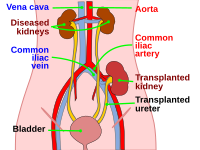
Photo from wikipedia
Background Accumulating evidence implicates the complement cascade as pathogenically contributing to ischemia-reperfusion injury and delayed graft function (DGF) in human kidney transplant recipients. Building on observations that kidney injury can… Click to show full abstract
Background Accumulating evidence implicates the complement cascade as pathogenically contributing to ischemia-reperfusion injury and delayed graft function (DGF) in human kidney transplant recipients. Building on observations that kidney injury can initiate in the donor before nephrectomy, we tested the hypothesis that anaphylatoxins C3a and C5a in donor urine before transplantation associate with risk of posttransplant injury. Methods We evaluated the effects of C3a and C5a in donor urine on outcomes of 469 deceased donors and their corresponding 902 kidney recipients in a subset of a prospective cohort study. Results We found a threefold increase of urinary C5a concentrations in donors with stage 2 and 3 acute kidney injury (AKI) compared donors without AKI (P < 0.001). Donor C5a was higher for the recipients with DGF (defined as dialysis in the first week posttransplant) compared with non-DGF (P = 0.002). In adjusted analyses, C5a remained independently associated with recipient DGF for donors without AKI (relative risk, 1.31; 95% confidence interval, 1.13-1.54). For donors with AKI, however, urinary C5a was not associated with DGF. We observed a trend toward better 12-month allograft function for kidneys from donors with C5a concentrations in the lowest tertile (P = 0.09). Urinary C3a was not associated with donor AKI, recipient DGF, or 12-month allograft function. Conclusions Urinary C5a correlates with the degree of donor AKI. In the absence of clinical donor AKI, donor urinary C5a concentrations associate with recipient DGF, providing a foundation for testing interventions aimed at preventing DGF within this high-risk patient subgroup.
Journal Title: Transplantation
Year Published: 2019
Link to full text (if available)
Share on Social Media: Sign Up to like & get
recommendations!